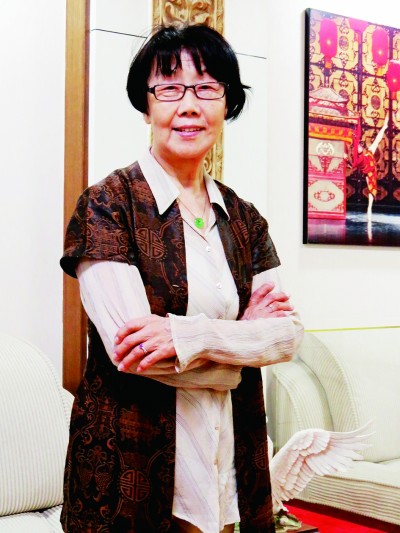【Chronicle of Literary and Artistic Characters】
Author: Yu Wei (member of Chinese Writers Association)
At the age of 84, she is the first “white swan” Odette who “takes off” in the Chinese ballet circle, and is also the first generation “Qionghua” in the ballet “Red Detachment of Women”. As a generation who pioneered, laid the foundation, and paved the way for Chinese ballet art, she devoted her whole life to the cause of Chinese ballet. She is still on the broad stage, dedicated to the inheritance of Chinese ballet.
Bai Shuxiang Photo by Yu Wei/Guangming Pictures
June 30, 1958, Beijing Tianqiao Theater. The dance music is melodious, and the pure and beautiful “White Swan” dances in the center of the stage… The world classic ballet “Swan Lake” rehearsed by New China premiered here.
On September 26, 1964, it was also Beijing Tianqiao Theater. A group of female soldiers carrying guns walked onto the stage, at first standing at attention, but soon stood on tiptoe, and “standing at attention” instantly turned into a ballet posture. This is the performance site of the first modern ballet “Red Detachment of Women” in New China.
The elegantly dressed old man in front of me is Bai Shuxiang, the leading actor of the above two ballets. She is the first “white swan” Odette who “takes off” in the Chinese ballet circle, and is also the first generation “Qionghua” in the ballet “The Red Detachment of Women”.
The 84-year-old Bai Shuxiang sat firmly on the sofa, looking at the old photos on the wall from time to time through the glasses, as if passing through the barrier of more than 50 years, her eyes are full of the light and shadow of her youth.
Bai Shuxiang was born in 1939 and was once the young protagonist of the Children’s Theater Troupe of the Northeast People’s Art Theater. At the age of 13, she also participated in the third condolences group to North Korea led by He Long. In 1954, the Beijing Dance School, the cradle of dancers in New China, was born. Bai Shuxiang became the first batch of students of the school, and has been associated with ballet ever since.
In the autumn of 1963, at the suggestion of Premier Zhou Enlai, the National Ballet of China began to create the ballet “Red Detachment of Women”. Soon, the crew was established, and Bai Shuxiang was selected to play Wu Qionghua. In February of the following year, Bai Shuxiang went to Hainan Island with the main creative team to experience life. There, she saw coconut trees, banyan trees and the beautiful Wanquan River for the first time, and personally experienced the living environment of the Red Detachment of Women.
After the gathering, the rehearsal of “Red Detachment of Women” was completed in only two months. But during the audition, a leader thought: “The temperament is not enough, the ‘ladies’ are full of ‘military’, holding ‘fire sticks’ in their hands!” So the crew immediately stopped the audition and went to Datong, Shanxi to “learn from the army”. Standing at attention, taking a rest, walking in unison, shooting, dropping bombs, marching in a hurry… “In order to experience the real military life, we often got up at night and packed our backpacks for night marches. As we ran, things fell out of the backpacks.” Bai Shuxiang recalled.
In addition to training, Bai Shuxiang also visited many places to study and understand the real life of the oppressed people in the old society, so as to better understand the character’s psychology. “We visited mass graves and heard many stories about mine owners oppressing miners. When I came back, I felt it immediately.” Bai Shuxiang said, “Therefore, it is very important to engage in artistic creation and penetrate into life.”
After returning to Beijing, Bai Shuxiang perfectly integrated Chinese folk dance, opera dance and western ballet, which greatly improved the expressive force of dance movements, and successfully created the image of Wu Qionghua who is “hard-bitten, tenacious, pungent and brave”.
On September 26, 1964, the ballet “The Red Detachment of Women” premiered at Beijing Tianqiao Theater. Premier Zhou Enlai stepped onto the stage after watching the performance, and affirmed “The Red Detachment of Women”: “My thinking is more conservative than yours. I thought it would be difficult for ballet to express modern life in China. It needs a transition, and I will perform a foreign revolutionary theme first.” repertoire. I didn’t expect your performance to be so successful!”
In the era when most Chinese people didn’t know what ballet was, “Red Detachment of Women” brought a revolution to ballet world–for the first time, the protagonist of ballet changed from a fairy to a warrior, and for the first time a ballet dancer held a ballet in a dance. Picking up steel knives and steel guns-the pointe dance with a history of hundreds of years in the West has been subverted in this way.
During the “Cultural Revolution”, Bai Shuxiang was impacted, unable to participate in performances, and was even banned from practicing. She was sent to work at the Xiaotangshan Cadre School in Changping, “every morning at 5:00, she began to pick up cow dung, boil water, and went to the city to collect dung.”
By 1973, the ballet had fewer and fewer performers. By chance, Premier Zhou mentioned Bai Shuxiang, which brought a ray of hope to her “reform” in the cadre school. After some twists and turns, Bai Shuxiang returned to the ballet troupe. That year, she was 34 years old.
The body suffers from various diseases, the muscles become stiff, and the body is overweight… Normally, it is difficult for a dancer to recover after one or two years of deprivation, but Bai Shuxiang has been deprived of it for nearly 10 years.
what to do? Is it time to bid farewell to the beloved stage? No! Bai Shuxiang recovered her body with tenacious perseverance. Running, swimming, dieting… practice in the morning, practice in the afternoon, and practice in the evening. “I remember that day when I was holding the practice pole, I suddenly cried. It seemed that the tears that had been accumulated for nearly ten years poured out in an instant.” After more than two months of hard training, a miracle appeared: Bai Shuxiang’s weight changed from 129 catties She dropped sharply to 106 catties, and at the same time, her basic skills also recovered quickly.
After returning to the stage, in addition to “Red Detachment of Women”, Bai Shuxiang also starred in “Ode to Yimeng”, “Children of the Grassland”, “Arrogant Yang”, “Dujuan Mountain” and so on. Since then, the first “white swan” in New China has regained its artistic youth.
In order to prolong her artistic life, Bai Shuxiang began to learn French at the age of 42, and went to France in 1982 for further studies. From Lyon to Cannes, from the Louvre to Fontainebleau, she eagerly absorbs the nutrition of foreign ballet art. After 1983, she studied the ballet genres of Britain, Denmark and other countries, and rehearsed “Fairies” and “Don Quixote”.
Bai Shuxiang is the generation that pioneered, laid the foundation and paved the way for Chinese ballet art. For decades, “Red Detachment of Women” has been staged again and again, and “Qiong Flower” has reached the sixth generation. Bai Shuxiang was delighted to see that every generation of Qionghua actors are constantly improving and breaking through. This is the most gratifying part of her “paving stone”.
“There are media reports that I left the stage when I was 50 years old. In fact, I didn’t officially leave the ballet stage until I was 65 years old. I haven’t completely retired until now.” This important pioneer of Chinese ballet is still committed to the inheritance of Chinese ballet on a broader stage.
“Guangming Daily” (page 12, January 15, 2023)
[
责编:张悦鑫 ]

